We travelled from Alexandria to Aswan by the overnight train. Getting onto the comfortable, sleeper train – not possible at the last minute, and at the time Egypt was in the process of introducing their two-tier pricing scheme on regular passenger trains. So we ended up paying a 350% inflated ‘special foreigners’ price, in first class which was wretched, dirty, and noisy. We actually thought they were lying to rip us off, but it was (and is) true – Egyptian railways has decided that foreigners will be the lifeblood of the business/don’t want us on trains at all in the first place. We’ve been to Egypt before and traveled by local transport with some amount of difficulty due to unclear rules, but always managed to get by sort of ‘on our own responsibility’. Now we abandoned trains altogether and went for the bus instead.

But since we were heading for Saudi Arabia next the bus wasn’t going to cut it. First, we thought about going to Sudan and taking the ferry from Port Sudan to Jeddah. This was before the current civil war. We’ve been to Sudan and would have to retrace our steps (although it would be fun to drop in on Magzoub). But that plus the fact that the security situation was already somewhat volatile, and that we couldn’t find any information about departure times from Port Sudan, all seemed like a bit much fuss so we scrapped that idea.
A couple of locals we talked to in Cairo and Alexandria hinted at there being ferries to Saudi Arabia from Hurghada or other places in Egypt, but no one knew much about it. Any sort of ticketing or travel agent we asked said no such thing existed and tried to sell us flights to Riyadh. That only strengthened our resolve and we were determined, Insh’Allah, to arrive in Saudi Arabia by ferry.
Based on a conversation with a taxi driver, and a single report we’d found online, we were fairly certain that there were in fact ferries going from Safaga in Egpyt to Duba, in Saudi Arabia. And as far as we could find out, there were no passenger ferries at all to Jeddah or leaving from anywhere else in Egypt. So after a few chill days in Aswan we headed back north to Luxor and from there to Safaga, which we’d never heard of before and with good reason, because it’s a fairly unappealing town.
This post is about our experience crossing the Red Sea from Egypt (Safaga) to Saudi Arabia (Duba) by ferry.
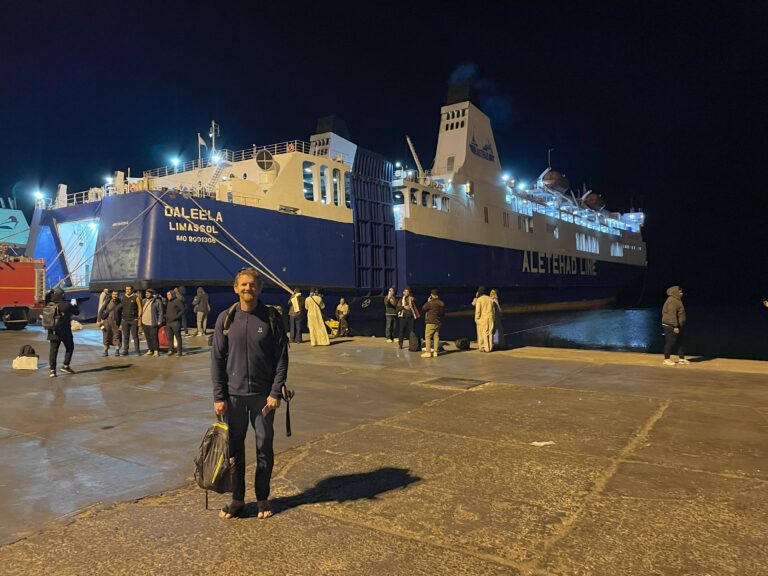
Before you go
You most likely need a visa for Saudi Arabia (check that, according to your nationality). The visa process is online and very straightforward.
The overnight ferry trip is about nine hours long, not counting a LOT of additional time for checking in, waiting, loading, dis/embarking, and so on. It runs every night but you have to find go to the office and get tickets ahead of time. You can’t just show up and try to buy on the spot at the port or online. I’ll get to all this in the next section.
The vessel has a very basic cafeteria with cheap food. It served breakfast in the morning of eggs, foul, bread, and tea. There was dinner available too. There’s a ‘family room’ for women and couples to eat in. Get used to that.
The ferry is a passenger and cargo vessel, so if you have a vehicle you can get it across. Shipping a car/motorcycle will entail a whole extra whack of formalities and I’ll bet it’s time-consuming. We saw the security officers removing the tires from a vehicle and running them through the x-ray in a pre-boarding inspection.
Have an eSim like Airalo already downloaded and ready to go. Bring the last of your local currency for food onboard – cash only, of course.
Remember, Saudi Arabia is very conservative. Women should cover up as much as possible but foreigners don’t need to wear a hijab or abaya. Most women in Saudi Arabia wear a fully covering black niqab, even though it’s not mandatory anymore. For that matter a lot of women wear it in Egypt.
Luxor to Safaga
Safaga is about three and a half hours by bus from Luxor. There are several bus companies near the train station in Luxor. We left late in the day so we spent the night in Safaga, plus the next night since it took an entire day to find the shipping line and get tickets. The ferry boards and leaves at night so in theory you could do it all in a day if you move fast.
Get your ferry tickets
Our very nice host in Safaga picked us up on the side of the road when we arrived well after dark, and drove us to the apartment we were staying in. On the way he showed us a ticketing office for a ferry company called Namma Shipping. He thought we might be able to get tickets there (we’d seen them online too, but couldn’t find any passenger info).
So the next day we walked around asking about ferries to Saudi Arabia at shipping offices and travel agents and random people near the port. With all signage in Arabic this was not particularly easy to do. We checked at a company called Triumph – they were closed. We checked in person at Namma Shipping but sure enough, they were no longer running passenger ferries. Eventually someone in a cargo office understood enough English to get what we were on about. He gave us the phone number of Mr. Alaa, who seemed to be singlehandedly responsible for all activities at the port. (NOTE: send me a message from the Contact page on this blog, if you want the phone number.)
Mr. Alaa told us to show up at his office later the same day – they don’t open most days before noon (get used to that before heading to Saudi Arabia, too). Mr. Alaa’s company’s name translates to International Union Shipping Company. They are also called Kenzy Travels, not sure if it’s a separate travel agency or an affiliate inside the shipping company, for handling ferry passengers. Doesn’t really matter. Either way, we found the office on the fourth floor of this building, next to the El Jawhara Inn. Look for the sign with an anchor on top of the building:
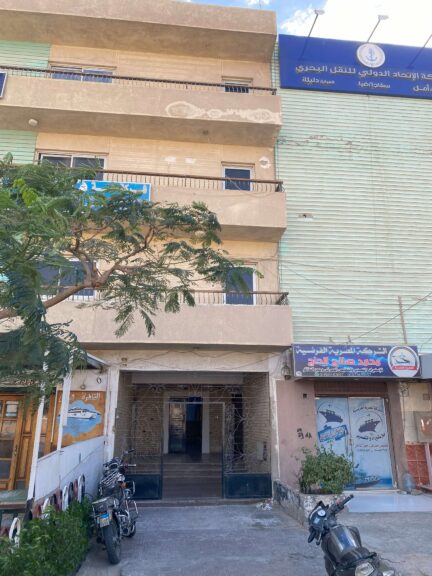
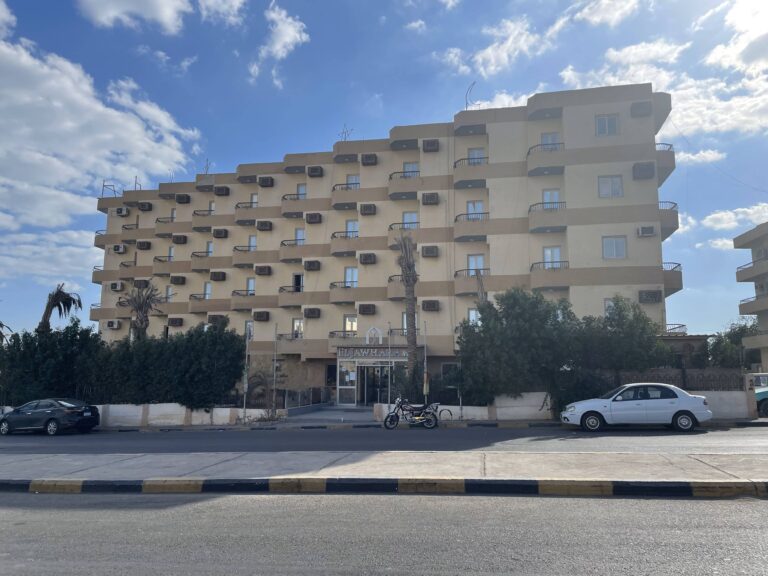
UPDATE in 2025: Kenzy Travels has moved their office to a location in front of the New Police Station.
Bring cash, your passport, and a printout of your e-Visa for Saudi Arabia.
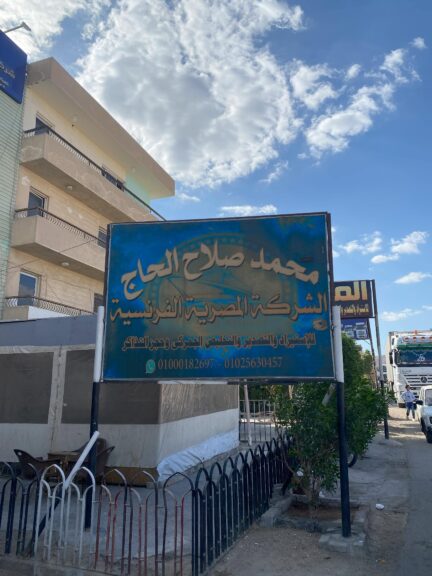
Mr. Alaa and his numerous colleagues were upstairs in their office chain-smoking. They gave us a breakdown of the ticket options and we sprung for a private cabin which was reasonable. The other option was regular open seating (Pullman seats) which I don’t think would be a particularly great idea. They took our passports and Saudi visas and spent an insanely long time entering everything in the computer, smoking, and printing stuff off.
We paid cash, and they told us to come back later the same evening to collect our documents and tickets, and board the ferry.
Yalla!
UPDATE in 2025: I’ve been told the process is more efficient now, and it’s possible to get your tickets right away and sail at 8pm on the same day.
Departure, and onboard the ferry
Back in the hazy cloud of smoke in Mr. Alaa’s office that evening, we collected our passports and sat waiting – for a couple of hours. Luckily there’s not much to do in Safaga anyway.
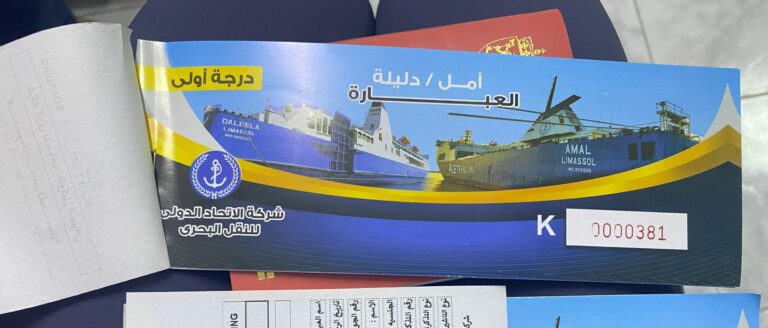
The office is within walking distance of the port and eventually we set off on foot with one of Mr. Alaa’s assistants. It seems that a personal escort to the port, through immigration, and onto the vessel is just part of the service. Not a bad idea actually, since the port is a bit of a maze. It’s not common for foreigners to make the trip and according to the passenger manifest we were the only two non-Egyptian or Saudi nationals onboard, so they kept tabs on us.

There are several stages of queueing up outside the port compound, showing your passport and ticket, and paying some small fees like departure tax for which you should get a receipt. Make sure you bring Egyptian pounds. There’s a short bus ride inside the port – we opted to walk since we were running low on pounds, and then a police officer ended up driving us.
Then you go inside and wait again with everyone’s passports in a huge pile on some officer’s desk while he and everyone else smokes like crazy. You can use the time to fill out some exit forms. Eventually, you’ll get your passport back with the stamp and can rush outside for fresh air and then wait for hours in another dense cloud of smoke until they let you board.
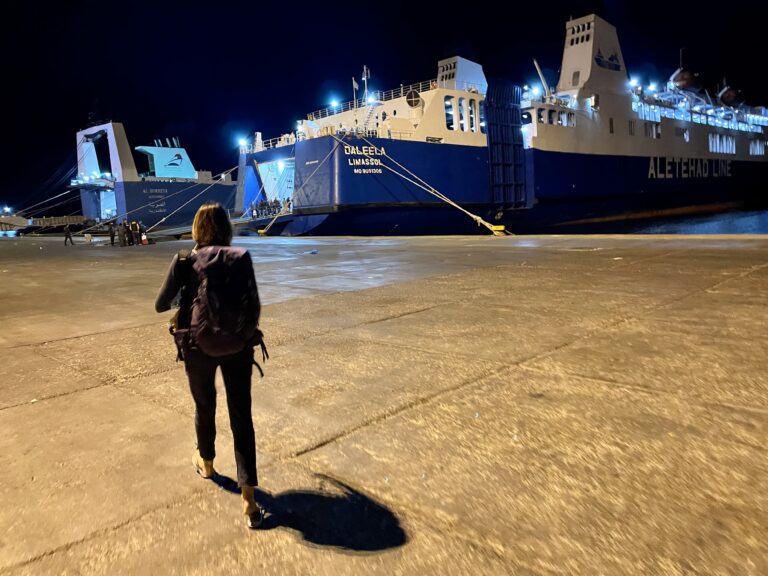
Foot passengers board the ferry first and then all the vehicles and transport trucks are loaded onboard. As you board you go straight to reception, show your boarding card, and get your cabin number and a key. We went to our comfortable cabin and made ourselves at home. Then we wandered around the vessel. No celebratory beers on this boat, by the way.
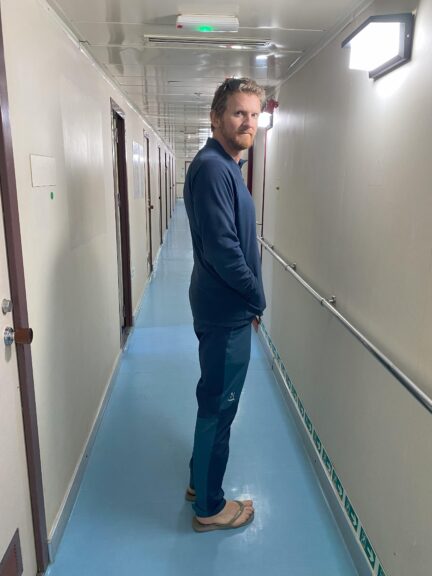
Don’t worry about setting an alarm. You’ll be woken up by morning prayer, broadcast over the ship loudspeakers and in your room.
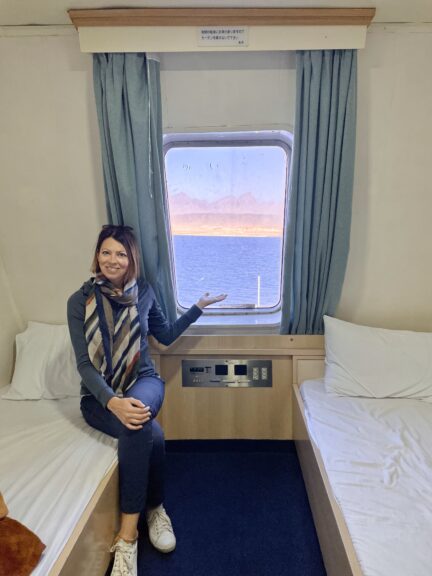
There’s plenty of time to get breakfast in the cafeteria and wander around the ferry. There are hot water samovars onboard and we had our aeropress along of course, so we made coffee and took a morning stroll.
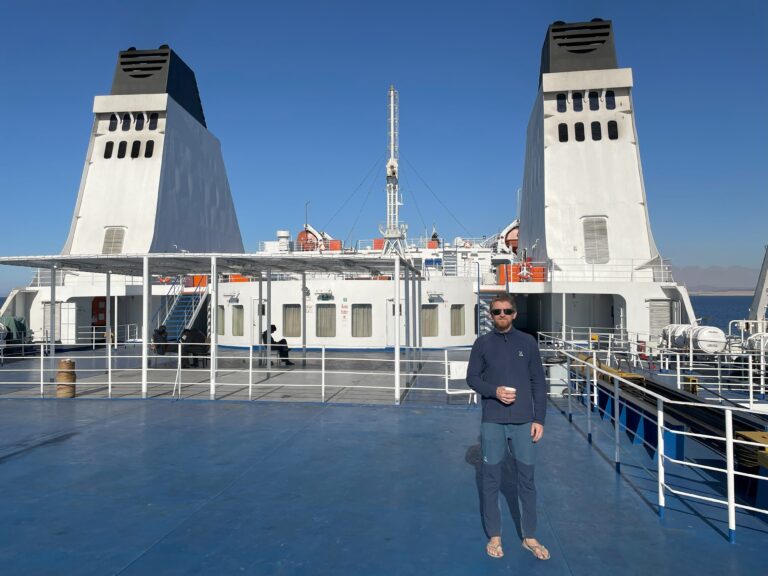
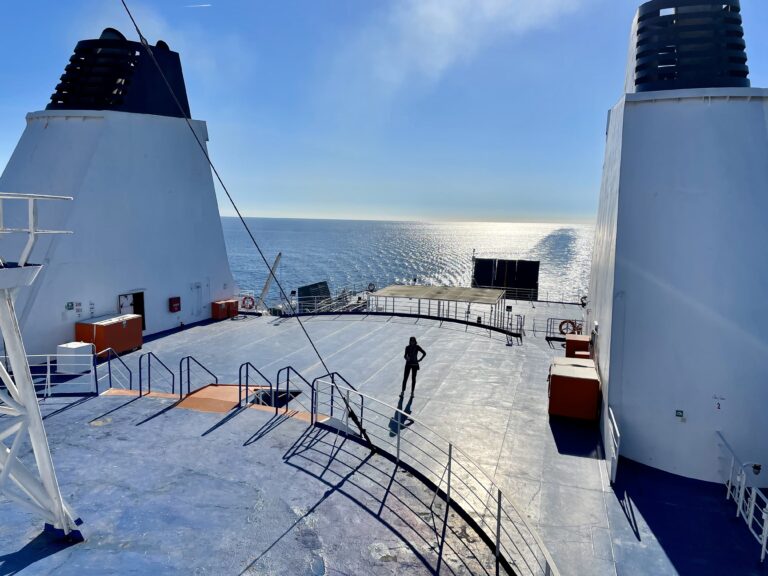
Arriving in Saudi Arabia
Although we were on the ferry in Egypt by about midnight, it didn’t actually depart until much later. We arrived in Saudi Arabia around 14:00 the next day, at the Port of Neom which is about thirty-eight kilometers north of Duba itself.

The port terminal is small and fairly organized. Join/start the queue for passport control and away you go! It took a very long time, even though we were the only two foreign nationals onboard. However, the immigration officer was the first person to wish me Happy Birthday, since Oyv forgot, so that was really nice.
We didn’t see any ATMs at the port, at least none that were operational.
Here’s a map with the blue pin indicating where the port is in relation to town:

Neom Port to Duba (the ‘Pearl of the Red Sea’)
Back in Egypt we’d met a friendly Saudi businessman who complained non-stop about Egyptians and was very keen to leave Egypt. He was traveling on the ferry with us and before we all went off to our cabins he’d enthusiastically welcomed us to Saudi Arabia and informed us we’d like it a lot better than Egypt (we liked Egypt just fine, a lot actually, but anyway).
The next morning we saw him again as we disembarked and he very kindly waited for us outside while immigration painstakingly processed our e-Visas. When we got out to the carpark we barely had a moment to realise there was no transport to town before he materialised beside us and offered a ride to Duba. We gratefully took him up on the offer and he not only drove us to Duba but insisted on helping us find a hotel.
Moral of the story, Saudi Arabia is a car-based country and public transport can be hard to come by in remote areas. The Neom port is in a remote area so you may have to rely on meeting a kind fellow passenger as we did, or hitch-hike to Duba. Apparently it’s easy to hitch-hike in Saudi Arabia, but they do drive like hell there, so be warned.
In Duba, which for some inscrutable reason is called the ‘Pearl of the Red Sea’, your accommodation options are expensive and limited – although not as limited as the food choices. I suggest you get some money (plenty of ATMs around), get a bus ticket, and get out the next day.
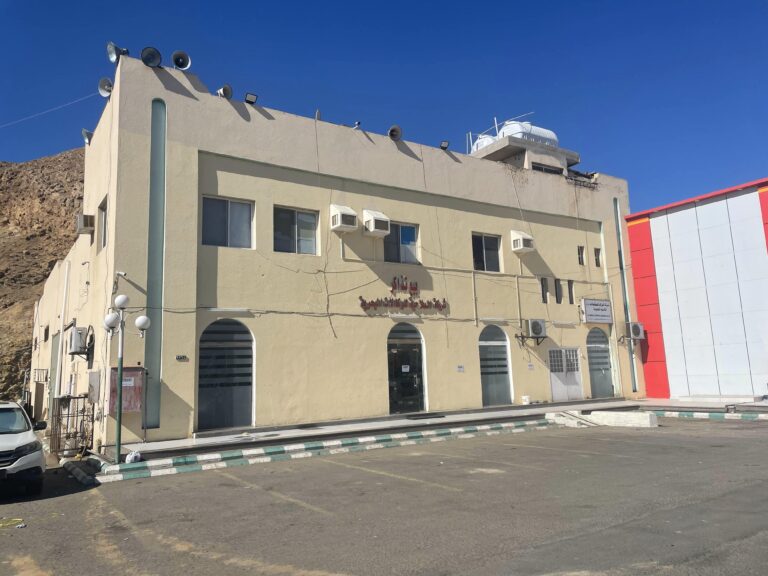
We stayed the night, got bus tickets, and traveled to Yanbu (five and a half hours), stayed a night there and carried on to Medina the day after that. That was a smooth trip – roads are good but distances are huge in Saudi Arabia.
Here’s a map with the blue pin indicating where we found the bus station and got our tickets. We stayed at one of a couple of hotels just two minutes away on foot:
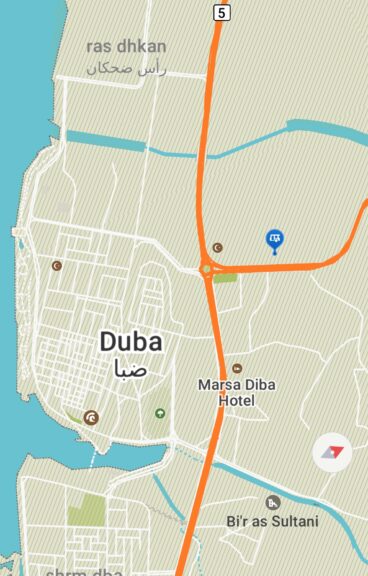
Incidentally, Duba is not the only ‘Pearl of the Red Sea’ we’ve come across. There’s an almost-ghost-town in Eritrea laying claim to the same nickname, and you can rest assured we’ve been there too.
Read More
Once you get to Saudi Arabia and are thinking about what to do next: have a look at our travel itinerary and route, here.
We’ve crossed a lot of borders by all sorts of random transport. Have a look at our border crossing reports and travel guides for strange stories and sage advice.

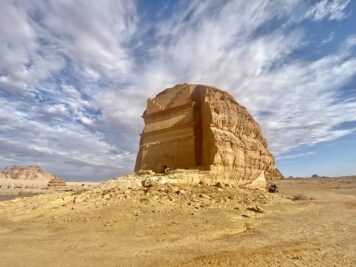
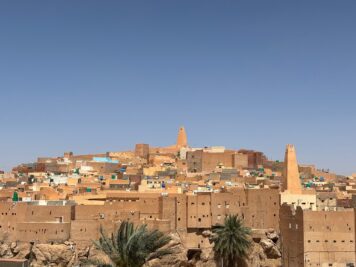
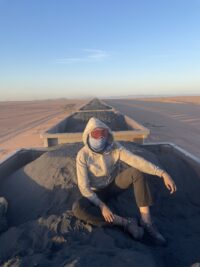
This Post Has 47 Comments
True, i face the same currently. The different that I’’ Egyptian and asked lots to know the process to travel using ferry. No one has any clue.
Hi! so, I’m not just going crazy…lol. Hope you can sort it out – try Safaga, it worked out pretty well in the end:)
Hi !
Thanks a lot for your testimony on this big adventure.
I am Theo, 24yo, and currently on slow travelling in Europe, Africa, Asia. I am in Egypt right now and plan to go Saudi Arabia next week. So your story is very precious to me, thanks !
I would like to know if it was possible for you to give me Mr. Alaa’s phone number, so that I could get a ticket more easily !
If you accept to, write to me on WhatsApp
Or by answering this post!
Thanks again,
Theo
Hi, you’re very welcome, and I’m happy to help:) I’ll message you with the phone number.
How much was your ticket?
I believe it was around 65 USD pp
Thank you Sara for you both for such avery descriptive adventure your story definitely inspired alots of Travellers and adventure seekers to venture in their own journey can you send me Mr alla number please iny email
Aw thanks:) Will do.
Hey,
Thanks a lot for all advices!
I will take this ferry with my bicycle in probably 2 months so its very usefull to me 🙏
You’re welcome! Hope it goes smoothly:)
Great story, Sarah!
We will be traveling in winter from Duba to Egypt. Could you send me the number of Alaa?
Hi! I will – but if you’re coming from Duba, I think you’re going to need to set it up on that side with an agency/somebody there instead.
Hi Sarah. Can I get Mr Alla phone number? And do you know if a rent a car in Egypt is possible to enter Saudi Arabia for 100 days and then drive back to Egypt?
Thanx
Hey, sent you the number. About the car rental, I wouldn’t know – but it sounds like it would be super complicated (cross-border…). I’d just rent a car in Saudi Arabia and drop it there after.
Hello Sara can you help with alla number am travelling from Egypt to Saudi for umrah I want try it
Hello, I sent it to you:)
Hello !
I am planning to go to Saudi Arabia from Egypt as well. Is it possible to have the number of the guy in the port ? Also, I would love hear your recommendation for Saudi Arabia ( where to go, what to do).
Thanks you very much for your blog it helps a lot !
Hi, thanks! I’m glad it helps:) And I’ve sent you the number. Happy travels!
Hey!
Thanks a lot for sharing all the process. It is very valuable as your are probably the only source of information on the Internet.
Would it also be possible to send me the phone number of Mr. Alaa as I should take it in a couple of days? 🙂
Have a nice day and travel! And thanks again!
You’re welcome, I’m happy it helps! I sent you the number. Happy travels:)
Hi Sarah,
You and your partner have inspired us. I read your travel through west africa.
Can you send me Mr Al’alaa number. This would remarkable journey..
Keep shinning. Respect from New Zealand
Hey, thanks – that’s nice to hear:) I sent you the number.
Hi Sarah,
Thank you for this article. Did you had any visa checks of your Egyptian visa on the boat ? Since mine is expired.
( I am Dutch)
I would love to hear it
Cheers
Kind wishes
M
Hey yeah of course, they checked the Egyptian visa before letting us board and leave from the port. Not sure but they likely checked it before issuing the tickets, too.
They check the visa when you are at the harbour. Mine was still valid but they didn’t counted the number of days I was in Egypt. So maybe they will let you go or, worst case scenario, you will have to pay a tax. Enjoy your trip!
Привет
Сколько придётся заплатить налог.
Наличными или можно с виза картой
Hi Sarah,
Thanks again for the article thanks to which I get the ferry :). I post a little update. Kenzy Tours moved their office to a place located in front of the New Police Station. And they are efficient now. You just need to come at 8pm to take the ferry the same day :).
I added some more details on the Duba page of Wikivoyage if someone is interesting in having more details.
Have good trips!
Awesome, thanks for the update as well! (also good to hear there’s a bit more efficiency now, lol)
Bonjour à tous
Merci pour vos informations très intéressantes et pratiques pour le voyage en bateau entre Safaga et Duba.
Quelle est l’adresse (ou nom de la rue) de Kenzy Tours ou du nouveau commissariat de police à Safaga?
A quelle heure et quelles fréquences ont lieu les départs depuis Safaga?
Prendre les billets le jour même à 20H00 pour le départ le même soir est il un peu risqué de ne pas avoir de place?
Bien à vous tous et prenez soin de vous
Robert
Such an excellent piece. Many thanks Sarah. I am going to egypt next week. Can you please share the phone number of Mr. Al’alaa?
Thanks, glad it helped:) Sent you the number. Have a great trip!
Привет, Сара. Могу ли я получить номер телефона господина Алaa?
Большое спасибо, что поделились всем процессом
Hi Sarah thanks for your coment about the excellent travel form Sarah to Arabia. Please send me the mobile number of Mr.Alla.
Best regards
Hey, you’re welcome:)
Hi Sarah, I am currently in Hurghada with my Bicycle planning to tage the Ferry to Duba the next days.
Could please share Mr. Alaas’s Numbers with me? It would help me alot!
Best Regards
Hi! I sent it to you. Have a good trip:)
Hello,Sarah. Thanks so much for sharing this amazing life learned trips. If not for this piece I would been mislead.may Godbless you for taking out ur time to enlightened us.pls can give mr Aalan phn no.thanks in anticipation. My regards
You’re welcome:) Sent you the number.
Hello Sarah, actually it’s very emergency time,I am writing the comment, I want to travel as early as possible, so I need his number, can you tell me how to contact with you?
Bonjour à tous
Encore merci pour ces informations très pratiques pour voyager entre Safaga et Duba.
1/ Avez-vous l’adresse ou le nom de la rue où se trouvent les locaux de Kenzy Tours à Safaga?
2/ Quand avez-vous pu acheter votre billet de bateau car un achat le soir même du départ me semble incertain d’avoir une place?
Bine à vous et prenez soin de vous et de vos proches
Robert
Hello, you’re welcome:) And I emailed you.
Hi Sarah, thank you so much for the share of your great experience, that really inspired me. I am planning to try to take ferry from Safaga to Duba with a car. Could you please share Mr. Alaa’s contact when have a chance? Thank you so much in advance!
Hi, you’re welcome! Will send:)
I would like to know if it was possible for you to give me Mr. Alaa’s phone number, so that I could get a ticket more easily !
If you accept to, write to me on WhatsApp.
We will come in Egipt with Roro boat from Italy with big camper, 15t.
Thanks again, Mojca
Sounds good, enjoy it!
Hi Sarah.
Really cool journey and thank you for telling us your experience. I also want to do the same journey and you’ve explained the process step by step which has made it easy for me.
Can you please send me Mr Alaa’s contact number if possible?
That’s great! I will do that:)